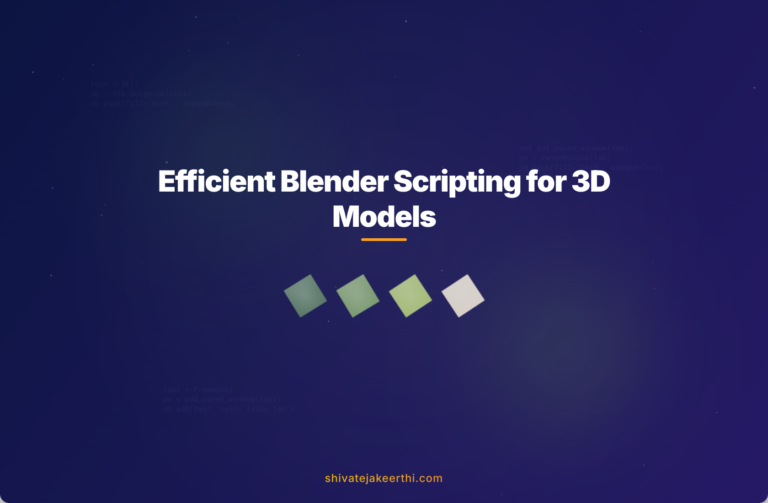Creating 3D models in Blender can sometimes be tricky—especially when you’re working with multiple coordinate points. If you’ve ever struggled with using Python to connect points, you’re not alone. Incorrect scripting often leads to Blender crashes or fragmented shapes exactly when you’re aiming for smooth 3D structures. In this guide, we’ll break down the essentials of writing an efficient Python script in Blender to properly connect these coordinate points.
Why Python is Essential for 3D Modeling in Blender
Blender comes equipped with extensive support for Python scripting, enabling you to automate tedious tasks, perform complex model manipulations, and streamline your workflow. Python scripts are particularly handy when dealing with repetitive tasks like connecting numerous coordinates or dynamically generating complex 3D models.
If you’re new to Blender scripting, here’s the basic idea: Python scripts interact directly with Blender’s internal data through Blender’s own Python API—bpy. With bpy, you can create, edit, duplicate, and animate objects and data without manual modeling.
Creating 2D Outlines with Initial Python Code
Typically, most Blender scripts for 3D modeling begin with simpler 2D outlines to form the foundation of a model. Let’s start with a basic script snippet to illustrate this within Blender’s Scripting workspace:
import bpy
coords = [(0,0),(1,0),(1,1),(0,1)]
mesh_data = bpy.data.meshes.new("square_mesh")
mesh_data.from_pydata(coords, [(0,1),(1,2),(2,3),(3,0)], [])
mesh_data.update()
obj = bpy.data.objects.new("SquareObject", mesh_data)
scene = bpy.context.scene
scene.collection.objects.link(obj)
In this snippet, the coordinates specify the corners of a simple square shape. However, this script results exclusively in 2D edges without proper faces, making it difficult to build upon when transitioning into a complete 3D object.
The main issue beginners often run into at this stage: not defining faces explicitly. Faces are crucial for creating solid objects in Blender, so simply drawing edges won’t suffice—even if visually they look connected, the object remains merely an outline.
Moving from 2D Outlines to Full-Fledged 3D Shapes
To progress from a simple 2D outline to a detailed 3D structure, we need a solid method to define faces and connect coordinate points correctly. Here’s an improved Python snippet demonstrating the creation of a basic cube:
import bpy
coords = [(0,0,0),(1,0,0),(1,1,0),(0,1,0),(0,0,1),(1,0,1),(1,1,1),(0,1,1)]
faces = [(0,1,2,3),(4,5,6,7),(0,1,5,4),(1,2,6,5), (2,3,7,6),(3,0,4,7)]
mesh_data = bpy.data.meshes.new("cube_mesh")
mesh_data.from_pydata(coords, [], faces)
mesh_data.update()
cube_obj = bpy.data.objects.new("CubeObject", mesh_data)
scene = bpy.context.scene
scene.collection.objects.link(cube_obj)
Now, we’ve defined vertices (coordinates of corners) and explicitly listed faces (connections between those vertices). With these faces, Blender can now correctly display the 3D geometry.
Troubleshooting Common Crashes and Errors
Often, Blender crashes when scripts try to access non-existent points or reference vertices incorrectly. Consider the following problematic code example that may cause Blender to freeze or crash:
# Potentially crashing code
import bpy
coords = [(0,0,0),(1,0,0),(1,1,0)]
# Creating faces with incorrect vertex indices
faces = [(0,1,3)]
mesh_data = bpy.data.meshes.new("bad_mesh")
mesh_data.from_pydata(coords, [], faces)
mesh_data.update()
You might immediately spot the mistake: vertex index 3 doesn’t exist. A face must reference existing vertices. Such minor errors often lead to frustrating crashes or errors. To prevent these issues, ensure all indices referenced in faces actually exist in your coordinate list.
Here are some helpful tips to avoid common Blender scripting errors:
- Always check that vertex indices exist before creating faces.
- Avoid redundant vertices, as extra points can slow down Blender unnecessarily.
- Use debugging tools provided within Blender’s scripting console for quick error messages. For more complex issues, sites like Stack Overflow can be a lifesaver.
Optimizing Your Python Code for Efficient Coordinate Connections
When dealing with complex 3D models containing hundreds or thousands of coordinate points, optimizing your script can significantly improve Blender’s performance and reduce crashes. Here are practical strategies to enhance your Blender scripting:
1. Grouping Similar Processes:
Rather than adding each vertex or face separately, group additions into batches. Blender handles batch operations more efficiently.
2. Using Functions for Repetitive Tasks:
Encapsulate repeated tasks into functions. It simplifies debugging and increases readability.
Here’s how you could structure your Python script more effectively:
import bpy
def create_mesh(coords, faces, mesh_name, obj_name):
mesh_data = bpy.data.meshes.new(mesh_name)
mesh_data.from_pydata(coords, [], faces)
mesh_data.update()
obj = bpy.data.objects.new(obj_name, mesh_data)
bpy.context.scene.collection.objects.link(obj)
# example use
cube_coords = [(0,0,0),(1,0,0),(1,1,0),(0,1,0),
(0,0,1),(1,0,1),(1,1,1),(0,1,1)]
cube_faces = [(0,1,2,3),(4,5,6,7),
(0,1,5,4),(1,2,6,5),
(2,3,7,6),(3,0,4,7)]
create_mesh(cube_coords, cube_faces, "OptimizedCubeMesh", "OptimizedCube")
This modular approach vastly improves readability, reduces crashes, and ensures fewer mistakes.
3. Avoid Excessive Loops:
Loops over vertices or faces can slow your script. Optimize loops by using built-in functions whenever you can. Check out this detailed guide on writing efficient Python code for more helpful examples.
Handling Large Volumes of Coordinate Points
When your project involves thousands of coordinates, it’s critical to avoid performance bottlenecks. For example, consider simplifying objects beforehand or breaking your model into manageable sub-components. This practice helps Blender handle the data effectively without overwhelming system resources or causing frustrating performance dips and crashes.
Another helpful method can involve mesh modifiers such as the Decimate Modifier to simplify complex geometry automatically after scripting, preserving necessary detail without manual tweaks.
Don’t underestimate the power of mesh optimization techniques. For more advanced mesh optimizing methods, you can reference Blender’s own official manual documentation for the Decimate modifier.
Creating visually appealing, computationally efficient 3D models using Python scripts within Blender not only saves vast amounts of time but dramatically boosts productivity.
Proper scripting also directly impacts the overall quality of renders and animation smoothness—making well-written Python code doubly critical for professional workflows.
Mastering the skill of connecting coordinates efficiently unlocks impressive possibilities within Blender. From generating intricate architectural designs to developing complex game assets, accurate Python scripting has real-world applications across multiple industries such as game design, architecture visualization, and more.
Have you ever struggled with Blender scripting? If yes, let us know your most challenging scripting experiences or your favorite Blender tips below!



0 Comments